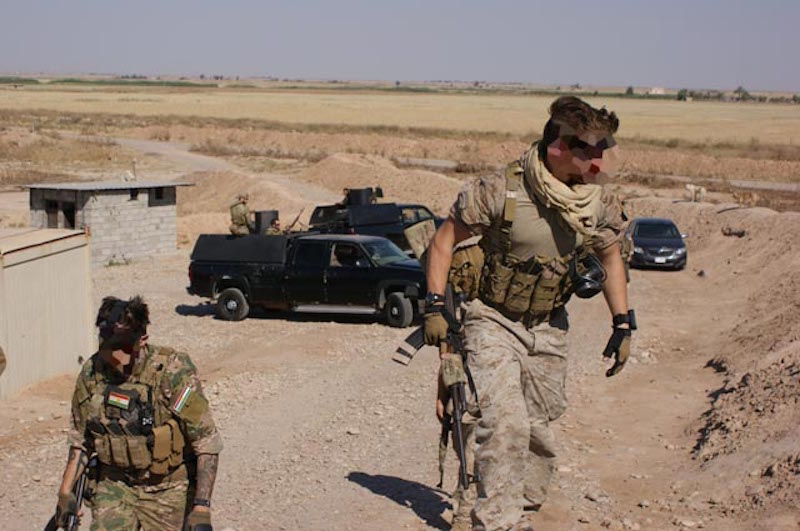Get the weekly SPARTANAT newsletter.
Your bonus: the free E-Book from SPARTANAT.
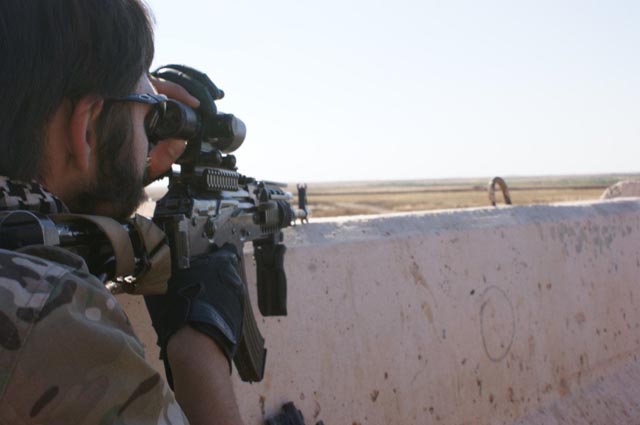
SPARTANAT in northern Iraq 2: In the front line
Departure! People are putting on their gear. The Western volunteers with the Peshmerga look pretty good, mostly wearing Plate Carriers, uniforms, and Chest Rigs. In Kurdistan, they don't really get anything: they are not paid, only provided with food and lodging. So Kurdish food and a sleeping mat at the base. When asked what they need, one of the Americans says, "MREs please." The Peshmerga don't have the money for suitable provisions, mostly rice is provided. Meat is a rarity. Otherwise, the impression is not one of living in prosperity: ammunition and weapons are self-procured. The team's medics are searching for all the necessary materials, from tourniquets to the required medical supplies for a Paramedic as described in the Ranger Handbook.
The convoy sets off with pick-up trucks as combat vehicles from the base through small villages. Checkpoints are seen repeatedly and rapidly in succession. During the day, things are relaxed; soldiers in flip-flops, with hardly any advanced fortifications. We go all the way to the front: the forwardmost position is an expanded outpost, created with construction equipment to overlook the plain. With bunkers made of hollow bricks or upside-down "U"-shaped concrete and a tower for observation and quarters, it looks like a small fortress, sandbags on the walls. Behind it, a pick-up truck with a "Dushka," a heavy machine gun, and a grenade launcher positioned next to it. The entire front consists of such outposts or houses surrounded by earth walls.
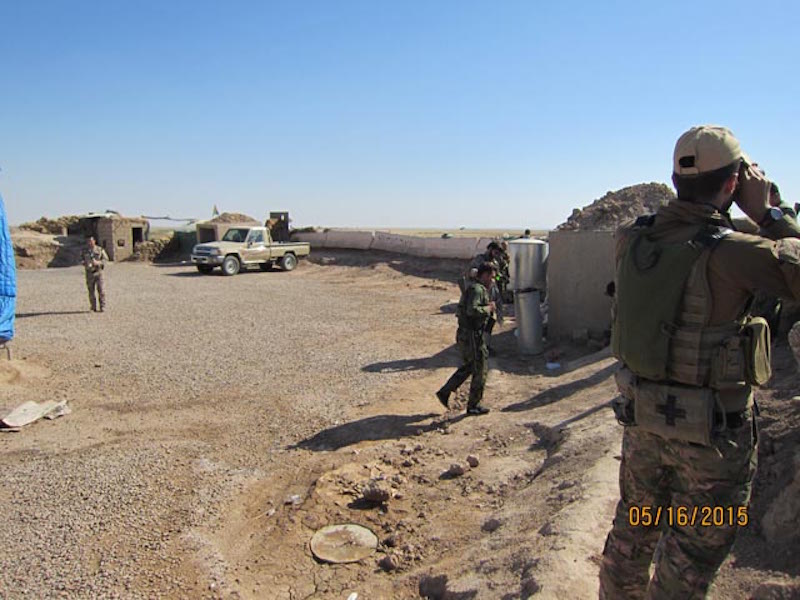 "Do you see the black flag?" It is indeed hard to make out. Cheerfully waving a Kurdish flag at a short distance. In the village behind it sits ISIS - as it is commonly referred to here. However, the Islamic State remains calm in the early afternoon. Volunteers with combat experience from previous tours in Iraq tell us that they are dealing with a militarily competent enemy. One unit once walked into a planned ambush by the jihadists and narrowly escaped. The opponents also have night vision and thermal imaging devices. When asked how he reached that conclusion, they say, "They always know exactly where we are at night." It's quiet during the day, which may also be because ISIS hides. "In the villages we recapture, we find tunnels, sometimes a kilometer long," another one tells us. The jihadists hide to evade the coalition forces' air superiority. "We have already had two JDAMs in this area," we learn. When things get stressful, observation teams show up to guide the laser-guided bombs weighing 500 to 1000 kilograms to their target. French, British, or Canadian special forces are at work there...
"Do you see the black flag?" It is indeed hard to make out. Cheerfully waving a Kurdish flag at a short distance. In the village behind it sits ISIS - as it is commonly referred to here. However, the Islamic State remains calm in the early afternoon. Volunteers with combat experience from previous tours in Iraq tell us that they are dealing with a militarily competent enemy. One unit once walked into a planned ambush by the jihadists and narrowly escaped. The opponents also have night vision and thermal imaging devices. When asked how he reached that conclusion, they say, "They always know exactly where we are at night." It's quiet during the day, which may also be because ISIS hides. "In the villages we recapture, we find tunnels, sometimes a kilometer long," another one tells us. The jihadists hide to evade the coalition forces' air superiority. "We have already had two JDAMs in this area," we learn. When things get stressful, observation teams show up to guide the laser-guided bombs weighing 500 to 1000 kilograms to their target. French, British, or Canadian special forces are at work there...
The Islamic State remains calm in the early afternoon. Volunteers with combat experience from previous tours in Iraq tell us that they are dealing with a militarily competent enemy.
 It is a beautiful, vast land that we spy from behind the wall. It looks so peaceful. "Where the dogs go to eat, dead terrorists lie in the grass," explains one of the Kurdish fighters about the consequences of the last attempted attack on the outpost, which was repelled. On the way back, peace is also very present. The first village is right behind the forwardmost outpost. Children play in the street, women stand at the door. "The volunteers are important to us," says the Iraqi general. "They help significantly in protecting the villages here." Some of these villages are Yazidi. And they know what ISIS does to these "infidels." The Westerners - especially those with military experience - also bring expertise. The Kurds are very brave and good soldiers, one tells us. But they lack military knowledge when it comes to more complex operations. Tactical training is a great asset here. And there is a lack of heavy weapons, especially. "We are very grateful for the international support, especially from the Germans," confesses General Aras.
It is a beautiful, vast land that we spy from behind the wall. It looks so peaceful. "Where the dogs go to eat, dead terrorists lie in the grass," explains one of the Kurdish fighters about the consequences of the last attempted attack on the outpost, which was repelled. On the way back, peace is also very present. The first village is right behind the forwardmost outpost. Children play in the street, women stand at the door. "The volunteers are important to us," says the Iraqi general. "They help significantly in protecting the villages here." Some of these villages are Yazidi. And they know what ISIS does to these "infidels." The Westerners - especially those with military experience - also bring expertise. The Kurds are very brave and good soldiers, one tells us. But they lack military knowledge when it comes to more complex operations. Tactical training is a great asset here. And there is a lack of heavy weapons, especially. "We are very grateful for the international support, especially from the Germans," confesses General Aras.
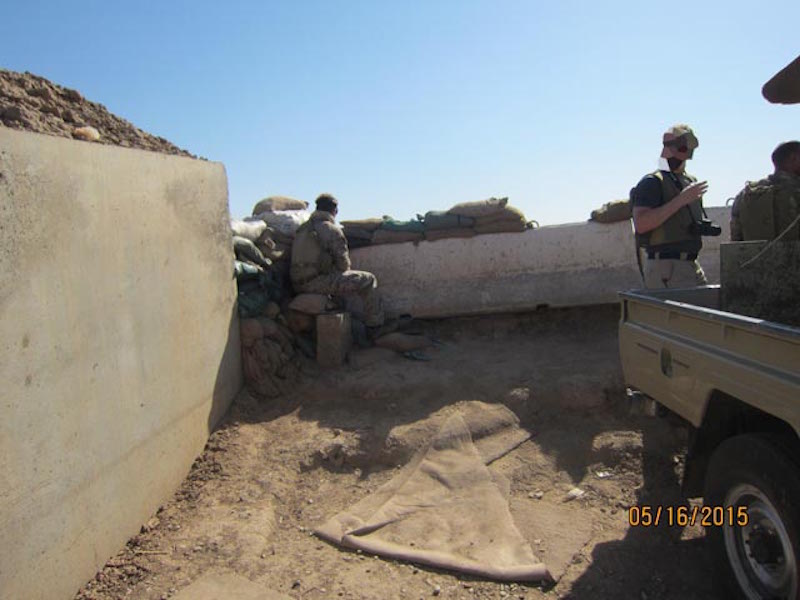 We see MG3 and even brand-new G3 rifles among the Kurds on site. The training of trainers by the Bundeswehr in Erbil, who, in turn, train Kurds at the front, doesn't always seem to work well. It is mentioned that some Kurds have complained that the laser on their G36 doesn't work. When told that the rifle doesn't have a laser, the owners point to the red dot sight. Another problem is that the ammunition supplied by the Bundeswehr is insufficient. This is less of an issue with the G36 than with the G3, which uses the former NATO-standard caliber. The costs of the war in Kurdistan, with the current recession, are not insignificant either: an AK-47 can be bought for around $550, and a shot is a dollar expensive. Those who can afford the luxury of a more precise M4 rifle pay $8,000 for it, nearly $100 for an empty magazine. The German assurance that the G36 won't fall into the wrong hands sounds somewhat hollow. The G36 is traded above the M4 in the Erbil market. The profit that can be made from selling this weapon is considerable and undoubtedly tempting.
We see MG3 and even brand-new G3 rifles among the Kurds on site. The training of trainers by the Bundeswehr in Erbil, who, in turn, train Kurds at the front, doesn't always seem to work well. It is mentioned that some Kurds have complained that the laser on their G36 doesn't work. When told that the rifle doesn't have a laser, the owners point to the red dot sight. Another problem is that the ammunition supplied by the Bundeswehr is insufficient. This is less of an issue with the G36 than with the G3, which uses the former NATO-standard caliber. The costs of the war in Kurdistan, with the current recession, are not insignificant either: an AK-47 can be bought for around $550, and a shot is a dollar expensive. Those who can afford the luxury of a more precise M4 rifle pay $8,000 for it, nearly $100 for an empty magazine. The German assurance that the G36 won't fall into the wrong hands sounds somewhat hollow. The G36 is traded above the M4 in the Erbil market. The profit that can be made from selling this weapon is considerable and undoubtedly tempting.
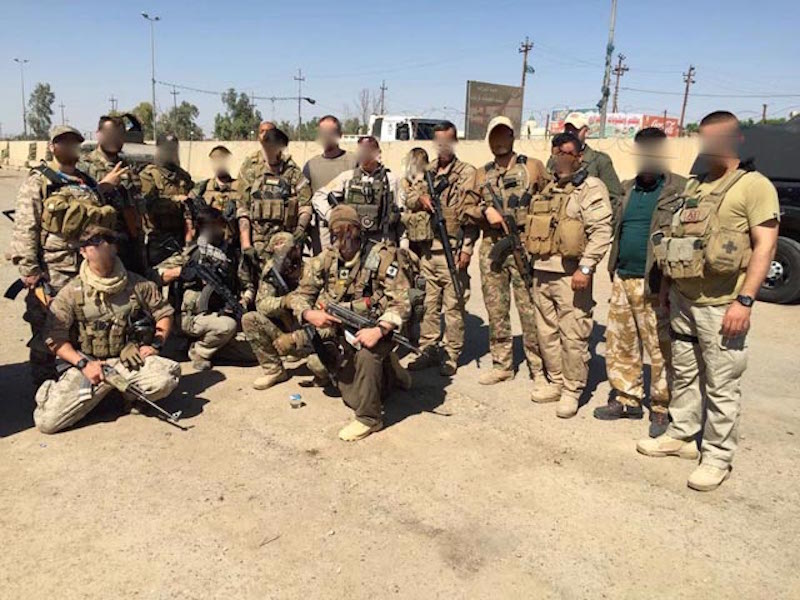 The soldiers and fighters we encounter make a very different impression on us. In terms of appearance, the best-equipped Kurdish soldiers are often seen in Erbil - standing guard in front of government and private facilities. At the front, the troops are more diverse, with soldiers wearing all kinds of uniforms, mostly from China and available via "Tactical Shops." The hierarchy appears strong, discipline less so, but the Kurds are tough and experienced fighters. As we drive back through the villages, we see another type of Kurdish fighter: members of the PKK are eyeing us. They are neatly uniformed, with young girls among them. Everyone we have talked to speaks respectfully of the PKK fighters. However, they also express the opinion that the PKK is already very "bled out" and weakened because of their courage and sacrifices. It is a fight that was forced upon the Kurds. "You see, our men are here to defend their homeland," General Aras tells us. "They have families, they want to visit them or they just ultimately want to go home and not have to fight." In contrast, ISIS terrorists would fight and even die. "They don't care at all."
The soldiers and fighters we encounter make a very different impression on us. In terms of appearance, the best-equipped Kurdish soldiers are often seen in Erbil - standing guard in front of government and private facilities. At the front, the troops are more diverse, with soldiers wearing all kinds of uniforms, mostly from China and available via "Tactical Shops." The hierarchy appears strong, discipline less so, but the Kurds are tough and experienced fighters. As we drive back through the villages, we see another type of Kurdish fighter: members of the PKK are eyeing us. They are neatly uniformed, with young girls among them. Everyone we have talked to speaks respectfully of the PKK fighters. However, they also express the opinion that the PKK is already very "bled out" and weakened because of their courage and sacrifices. It is a fight that was forced upon the Kurds. "You see, our men are here to defend their homeland," General Aras tells us. "They have families, they want to visit them or they just ultimately want to go home and not have to fight." In contrast, ISIS terrorists would fight and even die. "They don't care at all."
On the way back to Erbil, the armored vehicles stop by the roadside. "I want to buy some fruit," says the convoy's leader. We are at a vendor, all with weapons slung over our shoulders. Fist-sized radishes are a real temptation. Erbil is not a peaceful island either. In the surrounding area, there are large, well-organized refugee camps that have taken in people who have fled from places like Mosul. In Erbil itself, visitors can take wonderful tourist-style souvenir photos, but they will also learn that not too long ago, a car bomb exploded a few hundred meters away at a government building. Or they could be at a BBQ - 200 meters away from the American consulate - where a bomb was recently planted. "The cafe across the street where we used to go hasn't reopened," we hear from Westerners working here. Yes, many "expats" - professionals sent by their companies to work here - have already left. Due to the recession, which is a completely new experience for the Kurds... And the conversation quickly returns to the terrorists. Especially disturbed by the fact that ISIS has captured Ramadi just these days. There are also ISIS cells in Erbil. The front is only 30 minutes away.
HERE you can find the first part of "SPARTANAT in Northern Iraq"
SPARTANAT is the online magazine for Military News, Tactical Life, Gear & Reviews.
Send us your news: [email protected]
Ad
similar
Get the weekly SPARTANAT newsletter.
Your bonus: the free E-Book from SPARTANAT.


